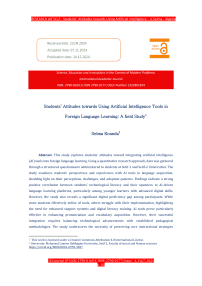Faculty of Social and Human Sciences
Автор: Selma Kounda
Журнал: Science, Education and Innovations in the Context of Modern Problems @imcra
Статья в выпуске: 4 vol.7, 2024 года.
Бесплатный доступ
This study explores students' attitudes toward integrating artificial intelligence (AI) tools into foreign language learning. Using a quantitative research approach, data was gathered through a structured questionnaire administered to students at Setif-1 and Setif-2 Universities. The study examines students' perspectives and experiences with AI tools in language acquisition, shedding light on their perceptions, challenges, and adoption patterns. Findings indicate a strong positive correlation between students' technological literacy and their openness to AI-driven language learning platforms, particularly among younger learners with advanced digital skills. However, the study also reveals a significant digital proficiency gap among participants. While some students effectively utilize AI tools, others struggle with their implementation, highlighting the need for enhanced support systems and digital literacy training. AI tools prove particularly effective in enhancing pronunciation and vocabulary acquisition. However, their successful integration requires balancing technological advancements with established pedagogical methodologies. The study underscores the necessity of preserving core instructional strategies while leveraging AI’s capabilities to optimize learning outcomes. By examining the intersection of technological proficiency and AI adoption in language education, this research contributes valuable insights into the evolving role of AI in foreign language learning. The findings suggest that while AI tools hold significant potential for enhancing language acquisition, their effectiveness depends on students' technical skills and a well-structured pedagogical framework.
Artificial Intelligence, student attitudes, foreign language learning, technology adoption, digital literacy
Короткий адрес: https://sciup.org/16010301
IDR: 16010301 | DOI: 10.56334/sei/7.4.8


